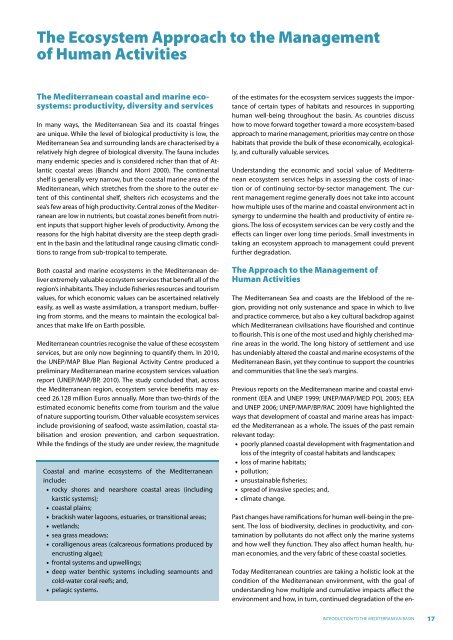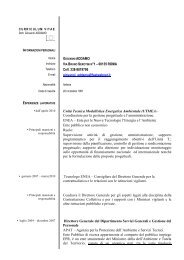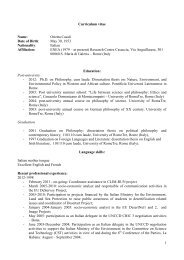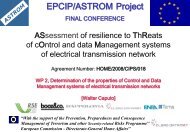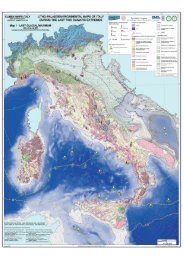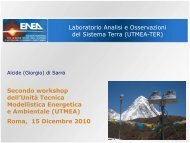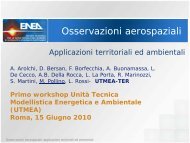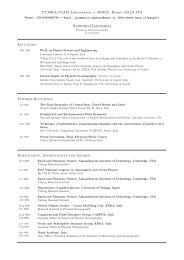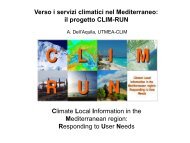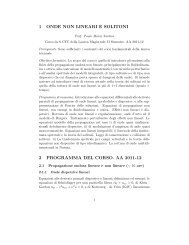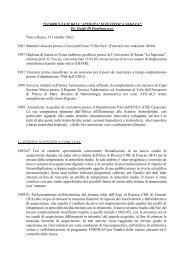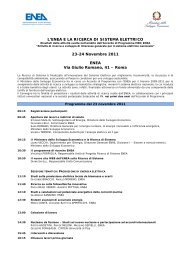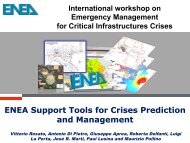State of the Mediterranean Marine and Coastal Environment
State of the Mediterranean Marine and Coastal Environment
State of the Mediterranean Marine and Coastal Environment
Create successful ePaper yourself
Turn your PDF publications into a flip-book with our unique Google optimized e-Paper software.
The Ecosystem Approach to <strong>the</strong> Management<br />
<strong>of</strong> Human Activities<br />
The <strong>Mediterranean</strong> coastal <strong>and</strong> marine ecosystems:<br />
productivity, diversity <strong>and</strong> services<br />
In many ways, <strong>the</strong> <strong>Mediterranean</strong> Sea <strong>and</strong> its coastal fringes<br />
are unique. While <strong>the</strong> level <strong>of</strong> biological productivity is low, <strong>the</strong><br />
<strong>Mediterranean</strong> Sea <strong>and</strong> surrounding l<strong>and</strong>s are characterised by a<br />
relatively high degree <strong>of</strong> biological diversity. The fauna includes<br />
many endemic species <strong>and</strong> is considered richer than that <strong>of</strong> Atlantic<br />
coastal areas (Bianchi <strong>and</strong> Morri 2000). The continental<br />
shelf is generally very narrow, but <strong>the</strong> coastal marine area <strong>of</strong> <strong>the</strong><br />
<strong>Mediterranean</strong>, which stretches from <strong>the</strong> shore to <strong>the</strong> outer extent<br />
<strong>of</strong> this continental shelf, shelters rich ecosystems <strong>and</strong> <strong>the</strong><br />
sea’s few areas <strong>of</strong> high productivity. Central zones <strong>of</strong> <strong>the</strong> <strong>Mediterranean</strong><br />
are low in nutrients, but coastal zones benefit from nutrient<br />
inputs that support higher levels <strong>of</strong> productivity. Among <strong>the</strong><br />
reasons for <strong>the</strong> high habitat diversity are <strong>the</strong> steep depth gradient<br />
in <strong>the</strong> basin <strong>and</strong> <strong>the</strong> latitudinal range causing climatic conditions<br />
to range from sub-tropical to temperate.<br />
Both coastal <strong>and</strong> marine ecosystems in <strong>the</strong> <strong>Mediterranean</strong> deliver<br />
extremely valuable ecosystem services that benefit all <strong>of</strong> <strong>the</strong><br />
region’s inhabitants. They include fisheries resources <strong>and</strong> tourism<br />
values, for which economic values can be ascertained relatively<br />
easily, as well as waste assimilation, a transport medium, buffering<br />
from storms, <strong>and</strong> <strong>the</strong> means to maintain <strong>the</strong> ecological balances<br />
that make life on Earth possible.<br />
<strong>Mediterranean</strong> countries recognise <strong>the</strong> value <strong>of</strong> <strong>the</strong>se ecosystem<br />
services, but are only now beginning to quantify <strong>the</strong>m. In 2010,<br />
<strong>the</strong> UNEP/MAP Blue Plan Regional Activity Centre produced a<br />
preliminary <strong>Mediterranean</strong> marine ecosystem services valuation<br />
report (UNEP/MAP/BP, 2010). The study concluded that, across<br />
<strong>the</strong> <strong>Mediterranean</strong> region, ecosystem service benefits may exceed<br />
26.128 million Euros annually. More than two-thirds <strong>of</strong> <strong>the</strong><br />
estimated economic benefits come from tourism <strong>and</strong> <strong>the</strong> value<br />
<strong>of</strong> nature supporting tourism. O<strong>the</strong>r valuable ecosystem services<br />
include provisioning <strong>of</strong> seafood, waste assimilation, coastal stabilisation<br />
<strong>and</strong> erosion prevention, <strong>and</strong> carbon sequestration.<br />
While <strong>the</strong> findings <strong>of</strong> <strong>the</strong> study are under review, <strong>the</strong> magnitude<br />
<strong>Coastal</strong> <strong>and</strong> marine ecosystems <strong>of</strong> <strong>the</strong> <strong>Mediterranean</strong><br />
include:<br />
• rocky shores <strong>and</strong> nearshore coastal areas (including<br />
karstic systems);<br />
• coastal plains;<br />
• brackish water lagoons, estuaries, or transitional areas;<br />
• wetl<strong>and</strong>s;<br />
• sea grass meadows;<br />
• coralligenous areas (calcareous formations produced by<br />
encrusting algae);<br />
• frontal systems <strong>and</strong> upwellings;<br />
• deep water benthic systems including seamounts <strong>and</strong><br />
cold-water coral reefs; <strong>and</strong>,<br />
• pelagic systems.<br />
<strong>of</strong> <strong>the</strong> estimates for <strong>the</strong> ecosystem services suggests <strong>the</strong> importance<br />
<strong>of</strong> certain types <strong>of</strong> habitats <strong>and</strong> resources in supporting<br />
human well-being throughout <strong>the</strong> basin. As countries discuss<br />
how to move forward toge<strong>the</strong>r toward a more ecosystem-based<br />
approach to marine management, priorities may centre on those<br />
habitats that provide <strong>the</strong> bulk <strong>of</strong> <strong>the</strong>se economically, ecologically,<br />
<strong>and</strong> culturally valuable services.<br />
Underst<strong>and</strong>ing <strong>the</strong> economic <strong>and</strong> social value <strong>of</strong> <strong>Mediterranean</strong><br />
ecosystem services helps in assessing <strong>the</strong> costs <strong>of</strong> inaction<br />
or <strong>of</strong> continuing sector-by-sector management. The current<br />
management regime generally does not take into account<br />
how multiple uses <strong>of</strong> <strong>the</strong> marine <strong>and</strong> coastal environment act in<br />
synergy to undermine <strong>the</strong> health <strong>and</strong> productivity <strong>of</strong> entire regions.<br />
The loss <strong>of</strong> ecosystem services can be very costly <strong>and</strong> <strong>the</strong><br />
effects can linger over long time periods. Small investments in<br />
taking an ecosystem approach to management could prevent<br />
fur<strong>the</strong>r degradation.<br />
The Approach to <strong>the</strong> Management <strong>of</strong><br />
Human Activities<br />
The <strong>Mediterranean</strong> Sea <strong>and</strong> coasts are <strong>the</strong> lifeblood <strong>of</strong> <strong>the</strong> region,<br />
providing not only sustenance <strong>and</strong> space in which to live<br />
<strong>and</strong> practice commerce, but also a key cultural backdrop against<br />
which <strong>Mediterranean</strong> civilisations have flourished <strong>and</strong> continue<br />
to flourish. This is one <strong>of</strong> <strong>the</strong> most used <strong>and</strong> highly cherished marine<br />
areas in <strong>the</strong> world. The long history <strong>of</strong> settlement <strong>and</strong> use<br />
has undeniably altered <strong>the</strong> coastal <strong>and</strong> marine ecosystems <strong>of</strong> <strong>the</strong><br />
<strong>Mediterranean</strong> Basin, yet <strong>the</strong>y continue to support <strong>the</strong> countries<br />
<strong>and</strong> communities that line <strong>the</strong> sea’s margins.<br />
Previous reports on <strong>the</strong> <strong>Mediterranean</strong> marine <strong>and</strong> coastal environment<br />
(EEA <strong>and</strong> UNEP 1999; UNEP/MAP/MED POL 2005; EEA<br />
<strong>and</strong> UNEP 2006; UNEP/MAP/BP/RAC 2009) have highlighted <strong>the</strong><br />
ways that development <strong>of</strong> coastal <strong>and</strong> marine areas has impacted<br />
<strong>the</strong> <strong>Mediterranean</strong> as a whole. The issues <strong>of</strong> <strong>the</strong> past remain<br />
relevant today:<br />
• poorly planned coastal development with fragmentation <strong>and</strong><br />
loss <strong>of</strong> <strong>the</strong> integrity <strong>of</strong> coastal habitats <strong>and</strong> l<strong>and</strong>scapes;<br />
• loss <strong>of</strong> marine habitats;<br />
• pollution;<br />
• unsustainable fisheries;<br />
• spread <strong>of</strong> invasive species; <strong>and</strong>,<br />
• climate change.<br />
Past changes have ramifications for human well-being in <strong>the</strong> present.<br />
The loss <strong>of</strong> biodiversity, declines in productivity, <strong>and</strong> contamination<br />
by pollutants do not affect only <strong>the</strong> marine systems<br />
<strong>and</strong> how well <strong>the</strong>y function. They also affect human health, human<br />
economies, <strong>and</strong> <strong>the</strong> very fabric <strong>of</strong> <strong>the</strong>se coastal societies.<br />
Today <strong>Mediterranean</strong> countries are taking a holistic look at <strong>the</strong><br />
condition <strong>of</strong> <strong>the</strong> <strong>Mediterranean</strong> environment, with <strong>the</strong> goal <strong>of</strong><br />
underst<strong>and</strong>ing how multiple <strong>and</strong> cumulative impacts affect <strong>the</strong><br />
environment <strong>and</strong> how, in turn, continued degradation <strong>of</strong> <strong>the</strong> en-<br />
INTRODUCTION TO THE MEDITERRANEAN BASIN<br />
17


